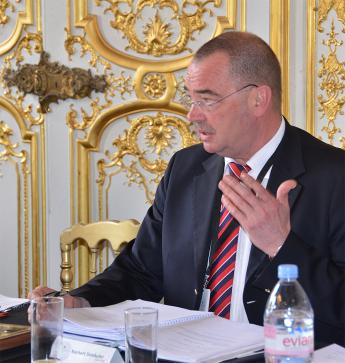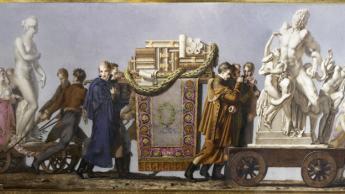News & Updates Verband der Antiquare Österreichs
The Written Heritage of Mankind in Peril: Theft, Retrieval, Sale and Restitution of Rare Books, Maps and Manuscripts

Talk given by ILAB President Norbert Donhofer at the international conference in the British Library, London
“Thefts of rare books, maps and manuscripts from libraries are a growing, global problem”, the Art Newspaper summarizes. “The portable nature of these works and the fact that many libraries lack up-to-date catalogues of their sizable collections - some of which were assembled centuries ago - make them prime targets. Two weeks before the conference, the Bibliothèque Nationale de France announced that several 16th- and 17th-century engravings by Brueghel as well as atlases dating from the 16th to 18th centuries had been stolen from its collection. An investigation is currently underway.“
ILAB President Norbert Donhofer was invited to speak at the conference at the British Library, which will be followed up by another international meeting in New York in 2016:
The Perspective of the Rare Book Trade
Good afternoon, Ladies and Gentlemen, and thank you, Monica, for introducing the speakers of this panel,
The topic of this panel reads as “The Perspective of the Rare Book Trade”, and as President of the International League of Antiquarian Booksellers (ILAB) I will try to present my view of the situation.
Before doing so let me briefly explain what ILAB is and what it stands for. In 1947 representatives from five countries, Denmark, France, the UK, the Netherlands and Sweden, met in Amsterdam to discuss the formation of such an umbrella association, with the aim of establishing new hope for international peace through open markets, to foster friendship and understanding, and to counteract the animosity and suspicion engendered by World War II. The ILAB was formally incorporated in Copenhagen in September of 1948, with associations from ten countries. Today, ILAB has as its members 22 national associations, representing 34 countries and around 1800 individual booksellers.
From the beginning ILAB had established a Code of Usages and Customs which defines the usages generally and universally recognized in all commercial transactions relating the profession, either between professionals, or between professionals and institutions or individuals. Antiquarian bookselling in this context includes manuscripts, autograph letters, prints, maps, drawings, as well as books, and any other written or printed material. Members of the national associations affiliated with ILAB should conduct all commercial transactions according to these usages which expressly indicate that members offer to their customers a clearly defined code of practice on high professional standards.
This Code of Usages and Customs contains also a paragraph about Stolen Property, and I quote: “Members shall be responsible for passing to the buyer clear title to all material sold, and shall not knowingly purchase, hold or attempt to re-sell stolen material. Due diligence practices include knowing, or confirming, the identity of a vendor, recording all purchases and taking reasonable steps to ensure the legitimacy of goods being offered. In the event of books suspected of having been stolen, or having been proved to have been stolen, it is the responsibility of the members to contact the original owner. They shall co-operate fully with law enforcement authorities to recover and return stolen material, and to apprehend those responsible.”
ILAB has also created a stolen books database back in 2010. This database has a public part and another part with exclusive access only for booksellers, which describes details such as circumstances of theft. This stolen book database is mainly used by our members but if any institution wants to have access or upload a list of stolen books they can contact the Security Chair of ILAB at any time, and they will certainly get access to this database. The most recent example happened only two days ago when ILAB’s security officer had spread out a long list of prints and atlases which had been stolen in the Bibliothèque Nationale de France! I am very glad that Denis Bruckmann from the BNF told me this morning that they are having already a hot trail to the stolen items, and Denis will report later about this issue in detail.
The enormous increase of spectacular thefts which had happened during the past years made it clear that ILAB had to do more than running a stolen book database. As soon as we get any information about a theft we try nowadays to get in contact to the damaged library and offer our help to bring light into the affair. I will give you now three examples of our interventions.
1) The successful example: Some three years ago a book theft had been detected in the library of an Austrian Monastery. The books were stolen by the assistant of the librarian, sold by him to a street dealer, who had sold all the 21 books to a German auction house. The books were sold at auction to various dealers. We had received the information of the theft shortly after the auction, and were able to retrieve all of them.
2) The partly successful example: Since May in 2012 we had tried to receive lists of the books stolen from the Girolamini Library – without any result. When Italian authorities started to confiscate books in Italy and Denmark back in 2014, just because they were suspected to have been stolen from Girolamini, ILAB protested sharply against this step. We were invited to discuss the problem with Italian authorities in Naples, and a short time later the books were given back to the owners who could clearly proof where the books had come from.
3) The unsuccessful example: Back in February this year a report about book thefts in the Russian National Library came to our attention. I immediately asked the President of our member, the Russian Association, to ask for lists of the stolen books but the President told me soon that the librarians refused to hand out such a list. As I know some librarians in high positions in Russia I had asked them to intervene – the result was the same: no lists. Unfortunately though I have to mention that such unsuccessful examples are still the majority as some libraries are still regarding thefts as secrets.
The most spectacular thefts, however, have attracted the interest of the media worldwide. I’ll spare you an enumeration of everything that has occurred in the last few years through criminal resourcefulness – you are all aware of the most prominent examples. Reports in the press, on TV and Radio, which have circulated the world, have damaged our profession severely and have doubtlessly left deep scars in its wake. This all culminated when the Girolamini scandal was brought to light back in 2012, and there was virtually no country in this world where this issue had not been reported. This scandal, when thousands of valuable and extremely valuable books had been pilfered from a library regarded as a cultural shrine, was definitely a new level. And this affair brought also to light something else: although it was not ILAB booksellers who cleaned out the Girolamini library, it was definitely ILAB booksellers who passed on and sold these books – at least some of those. A German auctioneer, based in Munich, was arrested and later onwards sentenced to five years in prison in Naples. He had received some 500 very valuable books from De Caro for his next auction. Some Italian booksellers were strongly suspected of having been involved in the case but no action was brought against one of those so far. It seems that De Caro cannot or does not want to remember the names of the buyers.
The consequences for the trade out of these thefts are manifold. In Italy the trade with old and valuable books, manuscripts, maps and prints has come more or less to a standstill and has even forced some booksellers to open offices abroad. In general it can be stated that virtually each Italian book from the 15th to the 17th century is currently suspected to have been stolen. Booksellers from all around the world are extremely nervous about early printed Italian books and it had happened several times so far that booksellers had accused other booksellers to have stolen books from the Girolamini Library in their stock. None of these suspicions could be proofed so far.
What counts even more is the fact that both, librarians and private customers, are extremely careful when purchasing a valuable item now – no matter if this item is an Italian, French, German or whatsoever one. It is nearly impossible to sell valuable items without an exact provenance but it is sometimes difficult and sometimes impossible to provide the buyer with such a provenance. Printed books are rarely unique but are available in multiple copies which differ in their state of preservation, binding etc. If such a book does not show any visible signs of being removed from some place, if the book has no notes, markings, bookplates or a significant binding, there is more or less no chance of knowing where the book came from. Booksellers are supposed to be cautious when buying from privates: they have to ask for an ID-card, make a visible bank-transfer, ask the seller where the book comes from – an often heard answer would be: from my grandfather – but the bookseller cannot be definitely sure if the seller tells the truth.
The librarians of many libraries, especially in the US, are checking suspiciously valuable items they had purchased during the past years, and this leads sometimes to positive results. It is only a week ago that a bookseller, who had bought a very valuable book at auction back in 1999, sold it to a library, and was given back this book earlier this year as it had turned out to have been stolen. The bookseller had paid back the amount to the library, and the book was given back to the Swedish National Library, from where it had been stolen by the librarian before 1999.
Like in other international associations, take the international association of art dealers, CINOA, for instance, I am absolutely sure that the vast majority of our affiliates are serious dealers, I know that some of our affiliates are sometimes a little bit careless for whatever reason, and it appears to be clear that few are permanently walking on the ridge by chasing the purchase of their lifetime. The large majority, however, knows that their reputation and good name, which took them decades to build those up, can be ruined in a day or even quicker.
The reputation of ILAB and all of its affiliates was certainly damaged in the past few years, and I can only repeat what I had said in a recent interview: Our most important task, however, is to rebuild the public image of the international antiquarian book trade. In the past years the reputation of the professional trade has been seriously damaged by spectacular thefts and forgeries. It is our duty to regain the confidence of our customers. This will only be possible if ILAB dealers hold up the standards defined in the Code of Usages and Customs of ILAB and its members.
***
Further reading:
‘You must guard your own henhouse and often from your own foxes’. Book trade calls for self-policing as library thefts are growing problem
The Written Heritage of Mankind in Peril: Theft, Retrieval, Sale and Restitution of Rare Books, Maps and Manuscripts
>>> Visit the official website
(Pictures: British Library, ILAB)

